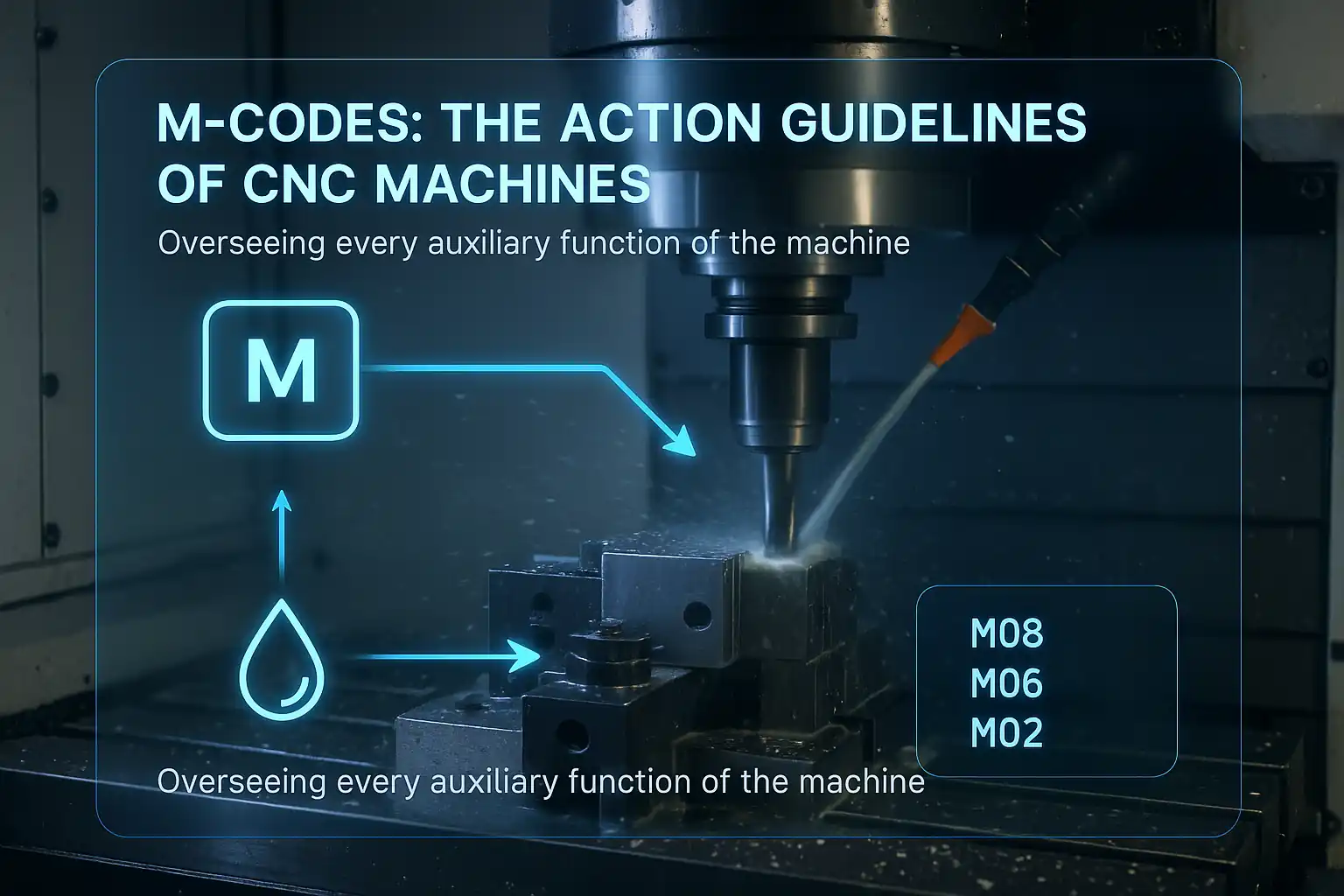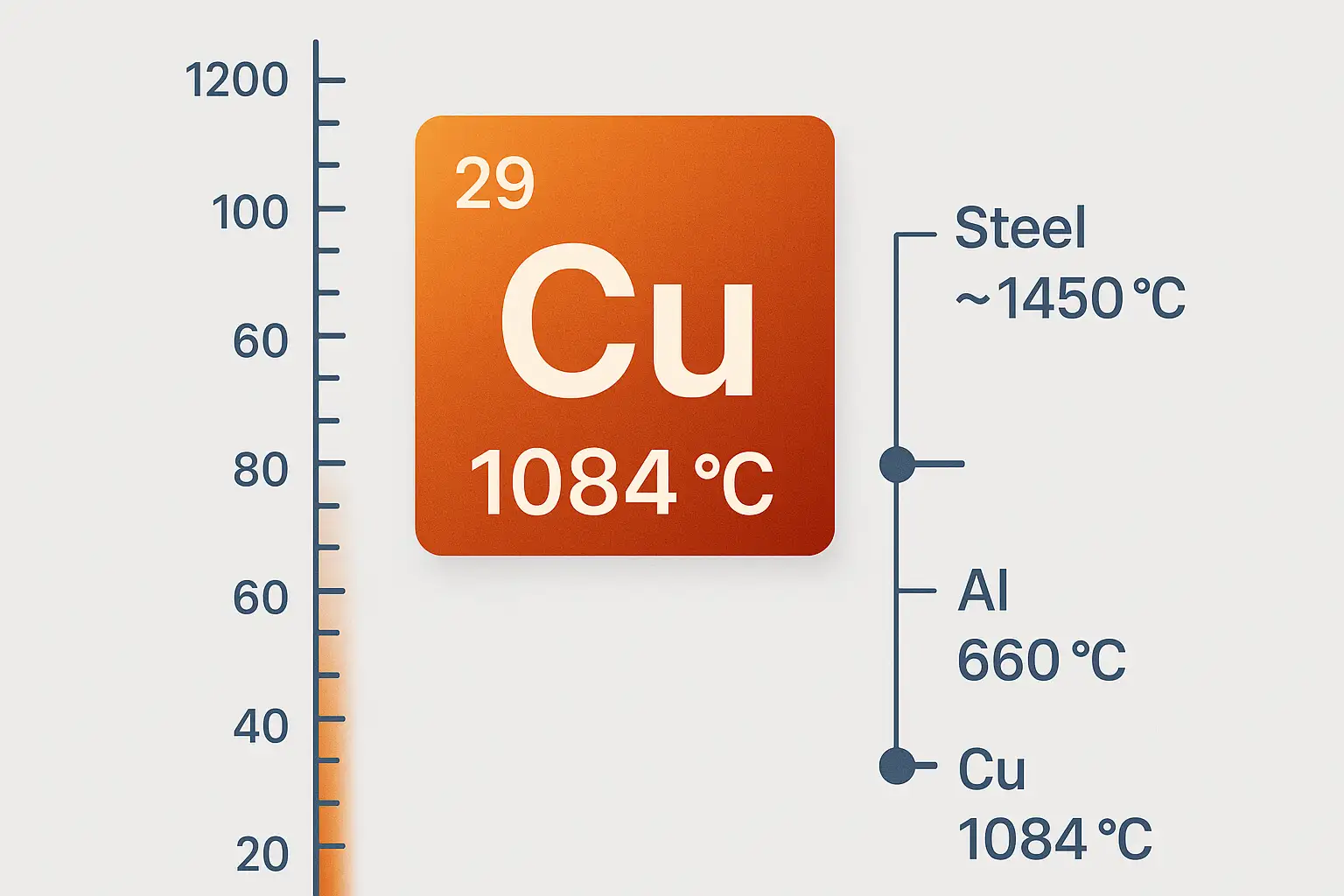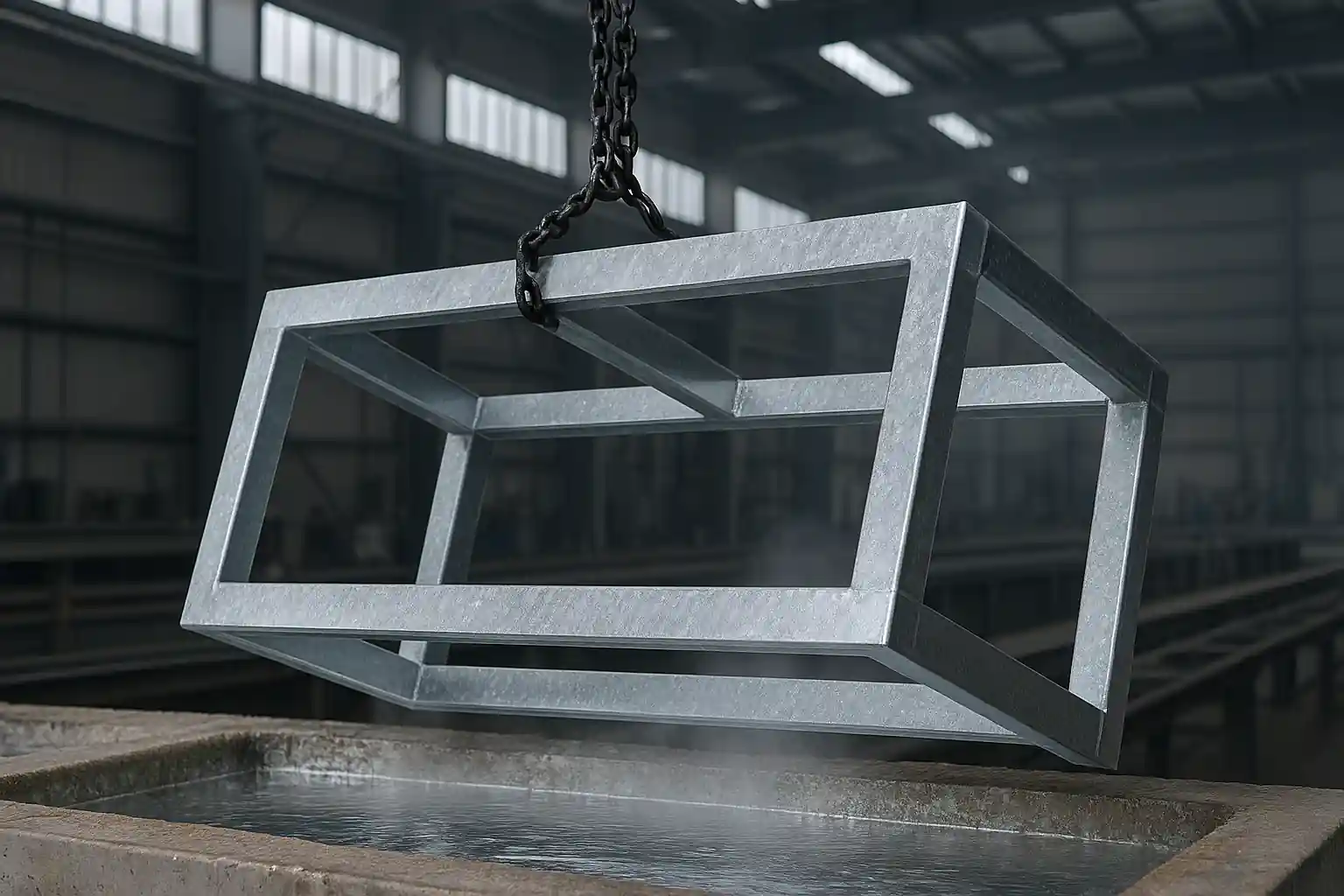What is M-Code?
M-Code, short for Miscellaneous Functions Code, is a core set of instructions in the CNC programming language. Its function is very direct: to control the non-cutting operations and auxiliary functions of a CNC machine. These functions include, but are not limited to, actions like turning the spindle on/off, controlling coolant flow, or executing a tool change. M-Code is a key command for achieving an automated machining process, allowing the machine to perform all tasks other than movement.
The Difference Between M-Code and G-Code

The main difference between G-Code and M-Code is that G-Code controls the machine’s movement and geometric path (e.g., linear or circular motion), while M-Code controls the machine’s auxiliary functions and non-cutting actions (e.g., turning on the spindle or changing a tool). Together, they form a complete CNC program.
The Origin of M-Code
The origin of M-Code isn’t tied to a single inventor, but rather to a collective industry effort to standardize CNC programming. It was formally established as part of the RS-274-D standard, which was developed and approved by the Electronic Industries Alliance (EIA) in 1965.
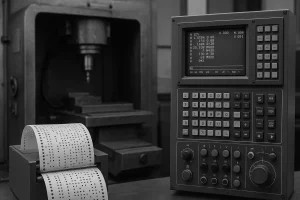
Before this landmark standard, there was no universal language for CNC machines. Manufacturers used their own proprietary programming “dialects,” making it impossible to run a program on a machine from a different company. The RS-274-D standard solved this problem by creating a shared language for commands like M-Code. This breakthrough enabled program portability, allowing a single program to work across different machines. This was a fundamental step towards modern, efficient, and automated manufacturing.
What Machines Use M-Code?
M-Code is a universal language widely used across various automated devices. A solid understanding of M-Code is fundamental to operating and programming these machines.
CNC Milling and Turning Machines
On traditional CNC milling and turning machines, M-Code is most commonly used for its core functions. It’s primarily used to control the spindle’s start and stop (M03/M05), to perform automatic tool changes (M06), and to turn the coolant on and off (M08/M09). These commands are essential for the auxiliary actions that enable precise machining.
Laser and Waterjet Cutting Machines
For laser and waterjet cutters, M-Code is used to control the activation of the energy source or fluid. For example, M-Code can turn the laser on and off or control the high-pressure water stream. It ensures that the cutting function is only activated after the tool has moved into the correct position, allowing for precise and controlled cuts.
3D Printers
M-Code is also crucial in the field of 3D printing. It’s often used to control the printer head’s heating elements (e.g., turning a heater on or off), manage the speed of cooling fans, and even control the movement of the print bed after a task is complete. These auxiliary functions ensure the printing process runs smoothly and the final product has high quality.
Industrial Robots
Some industrial robots with specific programming interfaces also use M-Code to control their end-of-arm tooling. For instance, an M-Code command can be used to control a robot’s gripper to pick up or release an object, or to trigger other external devices on a production line. This enables the automation of assembly and material handling tasks.
A solid understanding of M-Code is fundamental for operating and programming these machines,
Who Should Learn M-Code?
M-Code is an essential skill in the world of CNC manufacturing. The following groups should gain a deep understanding of M-Code:
- CNC Programmers: M-Code is a crucial component for writing complete, efficient, and safe machining programs.
- Machine Operators: Understanding M-Code helps operators better monitor machine behavior and perform debugging during a program’s run.
- Automation Engineers: For anyone designing or maintaining automated production lines, M-Code is fundamental to controlling equipment and managing process flow.
In short, anyone who wants to work in or is already involved in CNC machining and automated manufacturing should have a solid grasp of M-Code.
The Syntax of M-Code
The syntax for M-Code in CNC programming is straightforward and standardized. An M-Code command is simply the letter “M” followed by a two- or three-digit number, such as M03 or M30. Each command is executed one at a time and typically occupies its own line in the program.
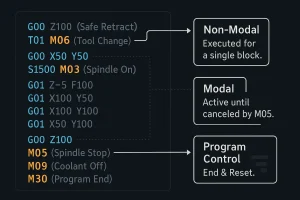
It’s important to understand the concept of modal vs. non-modal M-Codes. A modal command, like M03 (spindle on), stays active until another command, like M05 (spindle off), explicitly cancels it. This means you don’t need to repeat the command for every subsequent line. In contrast, a non-modal command only executes for the specific block of code it is in.
M-Code Syntax: A Quick Look
- Format: The letter “M” followed by a number (e.g., M08, M30).
- Execution: One command is executed per program block or line.
- Modal: Stays active until canceled by another command (e.g., M03 stays on until M05 is called).
- Non-Modal: Active only for the line it is written on.
Types of M-Code
This section categorizes M-Codes based on their function and provides a detailed breakdown of the most common and vital commands within each group. This structure offers a clear and practical reference for readers.
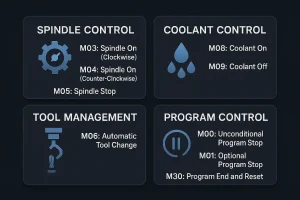
Spindle Control
- M03: Turns the spindle on in a clockwise (forward) direction. This is the most common command for starting the cutting process.
- M04: Turns the spindle on in a counter-clockwise (reverse) direction.
- M05: Stops the spindle.
Coolant Control
- M08: Turns the coolant on, providing essential lubrication and cooling to the tool and workpiece during machining.
- M09: Turns the coolant off.
Tool Management
- M06: Initiates an automatic tool change. This is a critical command for multi-tool operations, instructing the machine to retrieve the next tool from the tool magazine.
Program Control
- M00: An unconditional program stop. The machine will pause here and requires an operator to manually press the start button to resume.
- M01: An optional program stop. This command only takes effect if the optional stop switch on the machine is turned on.
- M30: Program end and reset. This command stops the program, resets it to the beginning, and stops the spindle and coolant, preparing the machine for the next machining cycle.
Practical Application and Examples of M-Code
To bridge the gap between theory and practice, let’s explore how M-Code and G-Code work together to create a complete machining program. The example below simulates a simple face milling operation. We’ll analyze each line to see how the “action” commands (M-Codes) perfectly align with the “motion” commands (G-Codes).
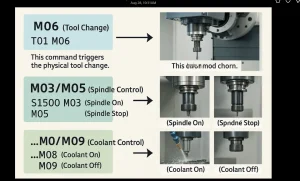
Example Program Analysis
Here’s a sample program for face milling a workpiece:
G-Code
(PROGRAM NAME - FACE MILLING)
(TOOL 1 - 10MM END MILL)
G21 G90 G40 G49 G17
G91 G28 Z0
G91 G28 X0 Y0
T01 M06 (Tool Change to Tool #1)
G00 G90 G54 X-20 Y-20 M08 (Rapid to Start Position, Coolant On)
S1500 M03 (Spindle On at 1500 RPM)
G43 H01 Z5 M08 (Tool Length Offset, Safe Z-Height)
G01 Z-2 F100 (Feed to Cutting Depth)
G01 X120 F250 (Cut across the X-axis)
G00 Z5 (Rapid out of the cut)
X-20 Y-10 (Rapid to next starting position)
G01 Z-2 (Feed to cutting depth)
G01 X120 (Cut again)
G00 Z5 (Rapid out)
M05 (Spindle Stop)
M09 (Coolant Off)
G91 G28 Z0 (Home Z-axis)
G91 G28 X0 Y0 (Home X and Y axes)
M30 (Program End and Reset)
Line-by-Line Breakdown
T01 M06: TheM06command initiates the most crucial non-cutting action: an automatic tool change. This action instructs the machine to retrieve tool number 1 from the tool magazine.... M08: This line usesM08to turn on the coolant, which will lubricate the cutting area and prevent the tool from overheating.S1500 M03: Here,M03commands the spindle to turn on in a clockwise direction. TheS1500is a G-Code address that sets the spindle speed to 1500 RPM.... M05: After the cutting is complete,M05is used to turn the spindle off.M09: Immediately after the spindle stops,M09turns the coolant off.M30: The program concludes withM30, a key program control command. It stops the program, resets it to the beginning, and prepares the machine for the next cycle.
This example clearly illustrates how M-Codes orchestrate the machine’s supporting actions, ensuring that the G-Codes for motion are performed under the correct conditions, resulting in a safe and efficient machining process.
Custom and Special M-Codes
Beyond the standard M-Codes (like M03, M08, and M30), many machine manufacturers have developed custom M-Codes to control functions unique to their equipment. These codes might manage automated doors, special clamps, tool measurement systems, or robotic part loaders. There is no universal standard for these custom codes, so you must always refer to the specific machine’s programming manual to use them correctly. Understanding this is crucial for programmers and operators when they’re working with non-standardized equipment.
Why are M-Code Numbers Non-Consecutive?
The non-consecutive numbering of M-Codes can seem confusing, but it isn’t random. Initially, M-Codes were part of a standardized list, like the RS-274-D standard, which assigned numbers in a more sequential way. However, as CNC technology evolved, new functionalities were developed, and different machine manufacturers added their own specific M-Codes. These new codes were assigned to available numbers rather than to maintain a continuous sequence. As a result, the full list of M-Codes is a dynamic set that varies significantly depending on the machine’s make and model.
M-Code Troubleshooting

Proper M-Code execution is vital for safety and efficiency in CNC machining. If programmed incorrectly, M-Codes can cause various issues. Here are some common problems and tips for troubleshooting them:
- Timing Errors: An incorrect sequence, like a G01 cutting command before an M03 spindle-on command, can cause an alarm or tool damage. Always ensure M-Codes are called before the related G-Codes they support.
- Program Not Ending: Forgetting to include M30 or M02 at the end of a program means the machine won’t automatically reset for the next cycle, requiring manual intervention.
- Conflicts with Machine State: Attempting a tool change (M06) while the spindle is still spinning can trigger a safety alarm. It’s important to program a sufficient pause or use a machine’s wait command to prevent such conflicts.
M-Code FAQ (Frequently Asked Questions)
1.What does M-code stand for?
M-Code stands for Miscellaneous Function Code.
2.What is the M-code used for?
M-Codes are used in CNC programming to control the machine’s auxiliary functions and non-cutting actions. These include commands for turning the spindle on/off, managing coolant flow, and initiating tool changes.
3.What do the M codes do?
M-Codes act as a set of commands that tell a CNC machine to perform specific actions or functions that are not related to tool motion or position. While G-Codes control where the tool goes, M-Codes control what the machine does.
4.What is the M-code for turning on coolant?
The M-code for turning on coolant is M08. The M-code for turning it off is M09.
